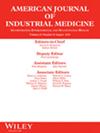Nonpharmacological pain management approaches among U.S. construction workers: A cross-sectional pilot study
Abstract
Background
U.S. construction workers experience high rates of injury that can lead to chronic pain. This pilot study examined nonpharmacological (without medication prescribed by healthcare provider) and pharmacological (e.g., prescription opioids) pain management approaches used by construction workers.
Methods
A convenience sample of U.S. construction workers was surveyed, in partnership with the U.S. National Institute for Occupational Safety and Health (NIOSH) Construction Sector Program. Differences in familiarity and use of nonpharmacological and pharmacological pain management approaches, by demographics, were assessed using logistic regression models. A boosted regression tree model examined the most influential factors related to pharmacological pain management use, and potential reductions in use were counterfactually modeled.
Results
Of 166 (85%) of 195 participants reporting pain/discomfort in the last year, 72% reported using pharmacological pain management approaches, including 19% using opioids. There were significant differences in familiarity with nonpharmacological approaches by gender, education, work experience, and job title. Among 37 factors that predicted using pharmacological and non-pharmacological pain management approaches, training on the risks of opioids, job benefits for unpaid leave and paid disability, and familiarity with music therapy, meditation or mindful breathing, and body scans were among the most important predictors of potentially reducing use of pharmacological approaches. Providing these nonpharmacological approaches to workers could result in an estimated 23% (95% CI: 16%–30%) reduction in pharmacological pain management approaches.
Conclusion
This pilot study suggests specific factors related to training, job benefits, and worker familiarity with nonpharmacological pain management approaches influence use of these approaches.


 求助内容:
求助内容: 应助结果提醒方式:
应助结果提醒方式:


